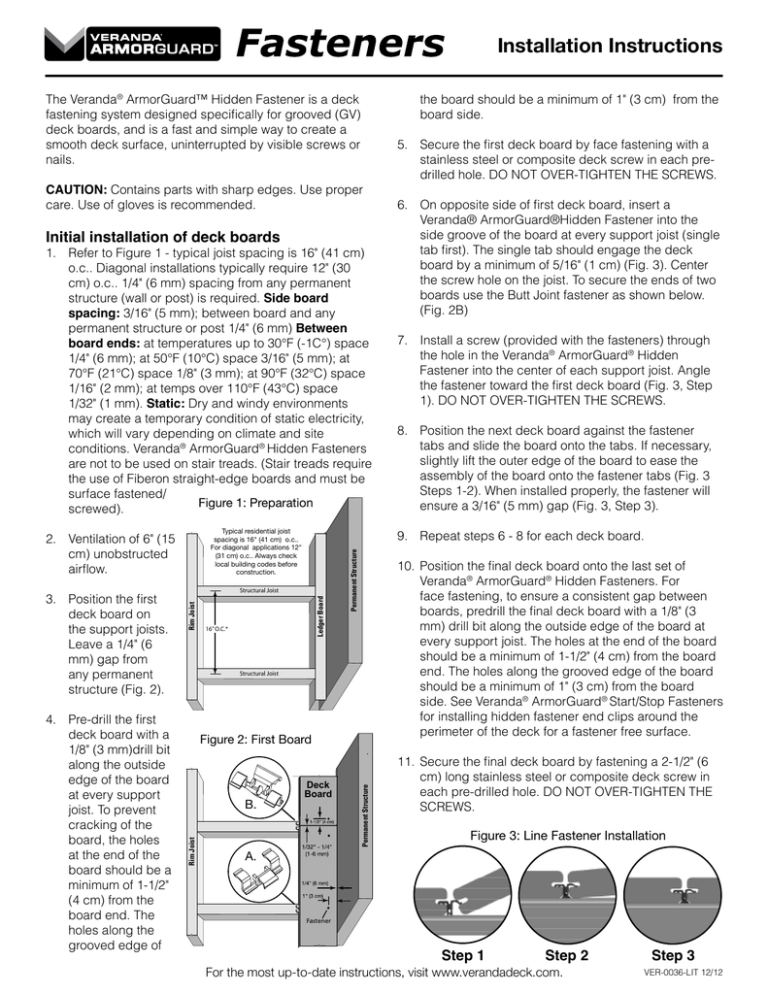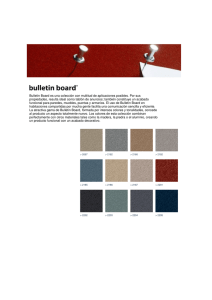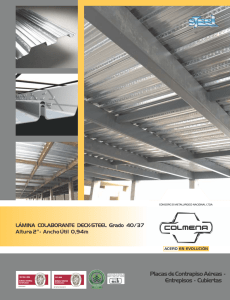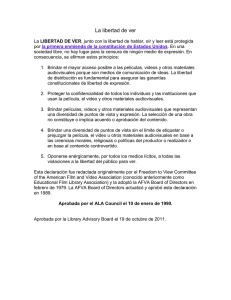Installation Instructions
Anuncio

Installation Instructions The Veranda® ArmorGuard™ Hidden Fastener is a deck fastening system designed specifically for grooved (GV) deck boards, and is a fast and simple way to create a smooth deck surface, uninterrupted by visible screws or nails. the board should be a minimum of 1" (3 cm) from the board side. CAUTION: Contains parts with sharp edges. Use proper care. Use of gloves is recommended. Initial installation of deck boards 1. Refer to Figure 1 - typical joist spacing is 16" (41 cm) o.c.. Diagonal installations typically require 12" (30 cm) o.c.. 1/4" (6 mm) spacing from any permanent structure (wall or post) is required. Side board spacing: 3/16" (5 mm); between board and any permanent structure or post 1/4" (6 mm) Between board ends: at temperatures up to 30°F (-1C°) space 1/4" (6 mm); at 50°F (10°C) space 3/16" (5 mm); at 70°F (21°C) space 1/8" (3 mm); at 90°F (32°C) space 1/16" (2 mm); at temps over 110°F (43°C) space 1/32" (1 mm). Static: Dry and windy environments may create a temporary condition of static electricity, which will vary depending on climate and site conditions. Veranda® ArmorGuard® Hidden Fasteners are not to be used on stair treads. (Stair treads require the use of Fiberon straight-edge boards and must be surface fastened/ Figure 1: Preparation screwed). Typical residential joist spacing is 16" (41 cm) o.c.. For diagonal applications 12" (31 cm) o.c.. Always check local building codes before construction. Ledger Board Rim Joist 16” O.C.* 8. Position the next deck board against the fastener tabs and slide the board onto the tabs. If necessary, slightly lift the outer edge of the board to ease the assembly of the board onto the fastener tabs (Fig. 3 Steps 1-2). When installed properly, the fastener will ensure a 3/16" (5 mm) gap (Fig. 3, Step 3). 10. Position the final deck board onto the last set of Veranda® ArmorGuard® Hidden Fasteners. For face fastening, to ensure a consistent gap between boards, predrill the final deck board with a 1/8" (3 mm) drill bit along the outside edge of the board at every support joist. The holes at the end of the board should be a minimum of 1-1/2" (4 cm) from the board end. The holes along the grooved edge of the board should be a minimum of 1" (3 cm) from the board side. See Veranda® ArmorGuard® Start/Stop Fasteners for installing hidden fastener end clips around the perimeter of the deck for a fastener free surface. Structural Joist Deck Board A. Permanent Structure . Figure 2: First Board B. 7. Install a screw (provided with the fasteners) through the hole in the Veranda® ArmorGuard® Hidden Fastener into the center of each support joist. Angle the fastener toward the first deck board (Fig. 3, Step 1). DO NOT OVER-TIGHTEN THE SCREWS. 11. Secure the final deck board by fastening a 2-1/2" (6 cm) long stainless steel or composite deck screw in each pre-drilled hole. DO NOT OVER-TIGHTEN THE SCREWS. Figure 3: Line Fastener Installation Structural Joist 4. Pre-drill the first deck board with a 1/8" (3 mm)drill bit along the outside edge of the board at every support joist. To prevent cracking of the board, the holes at the end of the board should be a minimum of 1-1/2" (4 cm) from the board end. The holes along the grooved edge of Structural Joist Rim Joist 3. Position the first deck board on the support joists. Leave a 1/4" (6 mm) gap from any permanent structure (Fig. 2). 6. On opposite side of first deck board, insert a Veranda® ArmorGuard®Hidden Fastener into the side groove of the board at every support joist (single tab first). The single tab should engage the deck board by a minimum of 5/16" (1 cm) (Fig. 3). Center the screw hole on the joist. To secure the ends of two boards use the Butt Joint fastener as shown below. (Fig. 2B) 9. Repeat steps 6 - 8 for each deck board. Permanent Structure 2. Ventilation of 6" (15 cm) unobstructed airflow. 5. Secure the first deck board by face fastening with a stainless steel or composite deck screw in each predrilled hole. DO NOT OVER-TIGHTEN THE SCREWS. Fastener Step 1 Step 2 For the most up-to-date instructions, visit www.verandadeck.com. Step 3 VER-0036-LIT 12/12 Installation Instructions The Veranda® ArmorGuard® Start/Stop Hidden Fastener is a deck fastening system designed specifically for a fastener free surface around the perimeter of the deck to create a smooth deck surface, uninterrupted by visible screws or nails. CAUTION: Contains parts with sharp edges. Use proper care. Use of gloves is recommended. • • • Place Start/Stop Hidden Fastener a minimum of 1/4" (6 mm) from wall and secure with a single screw into joist. Repeat no further than 16" (41 cm) on center, 12" (30 cm) on center for commercial. Position deck board, and insert clips into edge groove. It may be helpful to angle the board slightly to start the clips. With the deck board fully inserted into the clips, use Veranda® ArmorGuard® Hidden Deck Fasteners to secure the board along the other side (Figure 1). spaced no more than 12" (30 cm) apart. Tip: Use a field-made jig or clamp to keep the fascia/deck board fully engaged during installation. 7. Attach Start/Stop Fasteners to the underside of the rim joist, spaced no more than 12" (30 cm) apart (Figure 4). 8. Insert the lower deck board into the Veranda® ArmorGuard® Hidden Deck Fasteners, and secure the board by fully inserting a screw at an angle through the Start/Stop Fasteners and into the board, making sure to draw the board tight (Figure 5). 9. Continue around entire fascia surface. To secure the final deck board, there are two options using the Start/Stop Fasteners: 1. Position the clip on the inside of the rim joist securing it with a single screw inserted perpendicular to the joist. After positioning the last deck board in place, secure the board by angling a screw through the clip and into the board at a 30˚- 45˚ angle. Be careful to make sure the screw inserts fully and pulls the board down (Figure 2). When thickness of rim joist exceeds 1-1/2" (4 cm), End Clips should be secured to the outer edge of the joist. 2. Position the Start/Stop Hidden Fastener on the outside of the rim joist securing it with a single screw inserted perpendicular to the joist. After positioning the last deck board in place, secure it by angling a screw through the clip and into the board at a 30˚- 45˚ angle. Be careful to make sure the screw inserts fully and pulls the board down (Figure 3). Figure 1 Figure 2 Figure 3 Figure 4 Using two deck boards as fascia: (approximately 11-1/8" (28 cm) of fascia coverage) 3. Secure the outermost deck board using the Start/ Stop Fasteners with the longer leg secured into the rim joist, and spaced no more than 12" (30 cm) apart (Figure 3). 4. Size and cut the first fascia/deck board, allowing for 1/4" (6 mm) clearance from the wall or other hard structures. 5. Insert the fascia/deck board over the upper half of the rim joist and into the Start/Stop Fasteners. 6. Secure the lower edge of the deck board with Veranda® ArmorGuard® Hidden Deck Fasteners Figure 5 For the most up-to-date instructions, visit www.verandadeck.com. VER-0036-LIT 12/12 Sujeciones La sujeción oculta ArmorGuard® de Veranda® es un sistema de sujeción para entablados diseñado específicamente para tablas de entablados con ranuras (GV), y es una forma rápida y sencilla de crear una superficie de entablado lisa, sin interrupciones de tornillos ni clavos visibles. PRECAUCIÓN: Contiene piezas con bordes afilados. Preste atención. Se recomienda el uso de guantes. Instalación inicial de tablas para entablados Viga de borde 16" (40 cm) de centro a centro* B. A. Sujeción Estructura permanente . Figura 2: Primera tabla Tabla de entablado tabla deben estar a un mínimo de 1" (3 cm) desde el lado de la tabla. 5. Fije la primera tabla del entablado atornillando a la superficie con un tornillo de acero inoxidable o especial para entablados compuestos, en cada hoyo previamente perforado. NO APRIETE LOS TORNILLOS EN EXCESO. 6. En el lado opuesto de la primera tabla del entablado, inserte una sujeción oculta ArmorGuard® de Veranda® en la ranura lateral de la tabla en cada viga de soporte (pestaña única primero). La pestaña única debe ajustarse a la tabla del entablado con un mínimo de 5/16" (1 cm) (Fig. 3). Centre el hoyo para el tornillo en la viga. Para fijar los extremos de dos tablas use la sujeción a tope como se ilustra a continuación. (Fig. 2B) 7. Instale un tornillo (incluido con las sujeciones) a través del hoyo en la sujeción oculta ArmorGuard® de Veranda® en el centro de cada viga de soporte. Incline la sujeción hacia la primera tabla del entablado (Fig. 3, Paso 1). NO APRIETE LOS TORNILLOS EN EXCESO. 8. Coloque la tabla siguiente del entablado contra las pestañas de la sujeción y deslice la tabla sobre las pestañas. De ser necesario, levante un poco el extremo exterior de la tabla para facilitar el armado de la tabla sobre las pestañas de la sujeción (Fig. 3, Pasos 1 y 2). Cuando se haya instalado correctamente, la sujeción asegurará una holgura de 3/16" (5 mm) (Fig. 3, Paso 3). 9. Repita los pasos de 6 al 8 para cada tabla del entablado. 10. Coloque la tabla final del entablado sobre el último juego de sujeciones ocultas ArmorGuard® de Veranda®. Para fijar la superficie, a fin de asegurar una ranura constante entre tablas, perfore previamente la tabla final del entablado con una broca de 1/8" (3 mm) a lo largo del borde exterior de la tabla en cada viga de soporte. Los hoyos en el extremo de la tabla deben estar a un mínimo de 1-1/2" (4 cm) desde el extremo de la tabla. Los hoyos a lo largo del borde ranurado de la tabla deben estar a un mínimo de 1" (3 cm) desde el lado de la tabla. Vea las sujeciones de inicio/fin de ArmorGuard® de Veranda® para la instalación de sujeciones y broches extremos ocultos alrededor del perímetro del entablado a fin de obtener una superficie sin sujeciones visibles. Viga estructural Structural Joist 4. Perfore previamente la primera tabla del entablado con una broca de 1/8" (3 mm) a lo largo del borde exterior de la tabla en cada viga de soporte. Para evitar que la tabla se quiebre, los hoyos extremos deben estar a un mínimo de 1 1/2" (4 cm) desde el extremo de la tabla. Los hoyos a lo largo del borde ranurado de la Viga estructural Viga de borde 3. Coloque la primera tabla del entablado sobre las vigas de soporte. Deje una holgura de 1/4" (6 mm) desde cualquier estructura permanente (Fig. 2). La separación típica de vigas residenciales es de 16" (41 cm) de centro a centro. Para aplicaciones en diagonal 12" (30 cm) de centro a centro. Revise siempre los códigos locales de construcción antes de construir. Estructura permanente 2. Ventilación de flujo de aire de 6" (15 cm) sin obstrucciones. Tabla de apoyo extremo 1. Refiérase a la Figura 1, la separación típica entre vigas es de 16" (41 cm) de centro a centro. Las instalaciones en diagonal por lo regular requieren 12" (30 cm) de centro a centro. Se requiere una separación de 1/4" (6 mm) desde cualquier estructura permanente (pared o poste). Separación de tabla lateral: 3/16" (5 mm); 1/4" (6 mm) entre la tabla y cualquier estructura permanente o poste. Entre extremos de tablas: a temperaturas de hasta 30 °F (-1 °C) separación de 1/4" (6 mm); a 50 °F (10 °C) separación de 3/16" (5 mm); a 70 °F (21 °C) separación de 1/8" (3 mm); a 90 °F (32 °C) separación de 1/16" (2 mm); a temperaturas superiores a 110 °F (43 °C) separación de 1/32" (1 mm). Estática: Los ambientes secos y ventosos pueden crear una condición temporal de electricidad estática, la cual variará dependiendo del clima y las condiciones del lugar. Las sujeciones ocultas ArmorGuard® de Veranda® no deben usarse en escalones. (Los escalones requieren el uso de tablas de Veranda de bordes rectos y deben sujetarse/atornillarse en la superficie.) Figura 1: Preparación Instrucciones para instalación 11. Fije la tabla final del entablado con un tornillo de acero inoxidable o especial para entablados compuestos de 2 1/2" (6 cm) de largo en cada hoyo previamente perforado. NO APRIETE LOS TORNILLOS EN EXCESO. Figura 3: Instalación de sujeción en línea Paso 1 Paso 2 Para obtener las instrucciones más actualizadas, visite www.verandadeck.com. Paso 3 VER-0036-LIT 12/12 (Spanish) Instrucciones para instalación Sujeciones La sujeción oculta de inicio/fin de ArmorGuard® de Veranda® es un sistema de sujeción para entablados diseñado específicamente para una superficie libre de sujeciones alrededor del perímetro del entablado a fin de crear una superficie lisa de entablado, sin interrupciones de tornillos o clavos visibles. PRECAUCIÓN: Contiene piezas con bordes afilados. Preste atención. Se recomienda el uso de guantes. • • • Coloque la sujeción oculta de inicio/fin a un mínimo de 1/4" (6 mm) de la pared y fíjela con un solo tornillo en la viga. Repita a no más de 16" (41 cm) del centro, 12" (30 cm) del centro para aplicaciones comerciales. Coloque la tabla del entablado, e inserte los broches en la ranura del borde. Puede ser útil inclinar la tabla un poco para iniciar los broches. Con la tabla del entablado totalmente insertada en los broches, use las sujeciones ocultas ArmorGuard® de Veranda® para fijar la tabla a lo largo del otro lado (Figura 1). mantener la fascia/tabla del entablado correctamente colocada durante la instalación. 7. Fije las sujeciones de inicio/fin en la cara inferior de la viga de borde con una separación de no más de 12" (30 cm) (Figura 4). 8. Inserte la tabla del entablado inferior en las sujeciones ocultas ArmorGuard® de Veranda®, y fíjela insertando un tornillo por completo en un ángulo a través de las sujeciones de inicio/fin y en la tabla, cerciorándose de apretar la tabla estrechamente (Figura 5). 9. Continúe alrededor de toda la superficie de la fascia. Para fijar la tabla final del entablado, hay dos opciones con las sujeciones de inicio/fin: 1. Coloque el broche en el interior de la viga de borde fijándolo con un solo tornillo insertado perpendicular a la viga. Después de colocar la última tabla del entablado en su sitio, fije la tabla colocando un tornillo inclinado a través del broche y la tabla, con un ángulo de 30° a 45°. Cerciórese de que el tornillo entre completamente y sujete la tabla hacia abajo (Figura 2). Cuando el grosor de la viga de borde excede 1 1/2" (4 cm), los broches extremos se deben fijar al borde exterior de la viga. 2. Coloque la sujeción oculta de inicio/fin en el exterior de la viga de borde periférica fijándolo con un solo tornillo insertado perpendicular a la viga. Después de colocar la última tabla del entablado en su sitio, fíjela colocando un tornillo inclinado a través del broche y la tabla, con un ángulo de 30° a 45°. Cerciórese de que el tornillo entre completamente y sujete la tabla hacia abajo (Figura 3). Figura 1 Figura 2 Figura 3 Figura 4 Uso de dos tablas de entablado como fascia: (aproximadamente 11-1/8" (28 cm) de cobertura de fascia) 3. Fije la tabla más exterior del entablado con las sujeciones de inicio/fin con la pata más larga fijada en la viga de borde, y con una separación no mayor de 12" (30 cm) (Figura 3). 4. Mida y corte la primera fascia/tabla de entablado, dejando un espacio de 1/4" (6 mm) desde la pared u otra estructura sólida. 5. Inserte la fascia/tabla de entablado sobre la primera mitad de la viga de borde y en las sujeciones de inicio/fin. 6. Fije el borde inferior de la tabla del entablado con sujeciones ocultas ArmorGuard® de Veranda® con una separación no mayor de 12" (30 cm). Sugerencia: Utilice una guía o abrazadera hecha en sitio para Figura 5 Para obtener las instrucciones más actualizadas, visite www.verandadeck.com. VER-0036-LIT 12/12 (Spanish)





